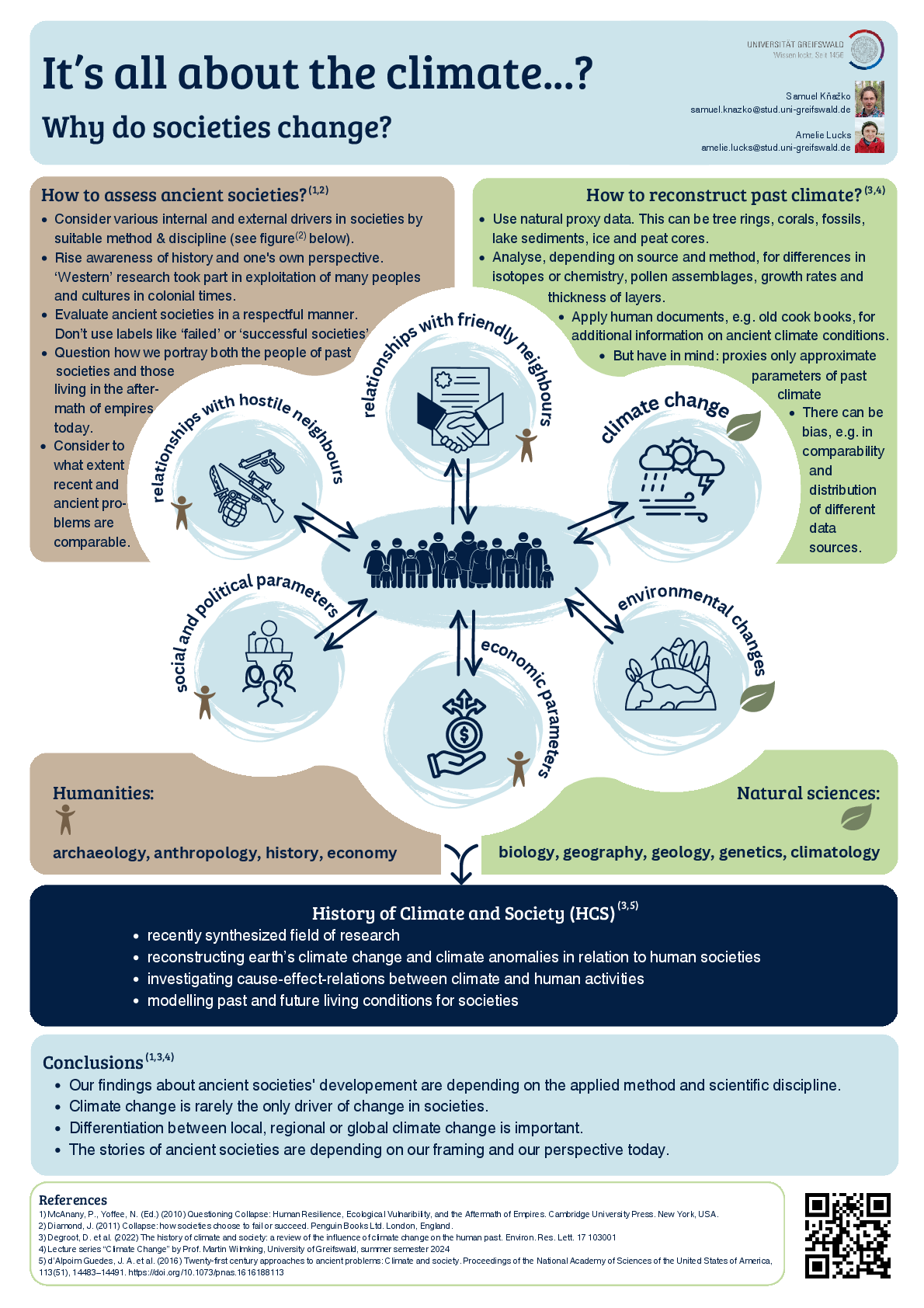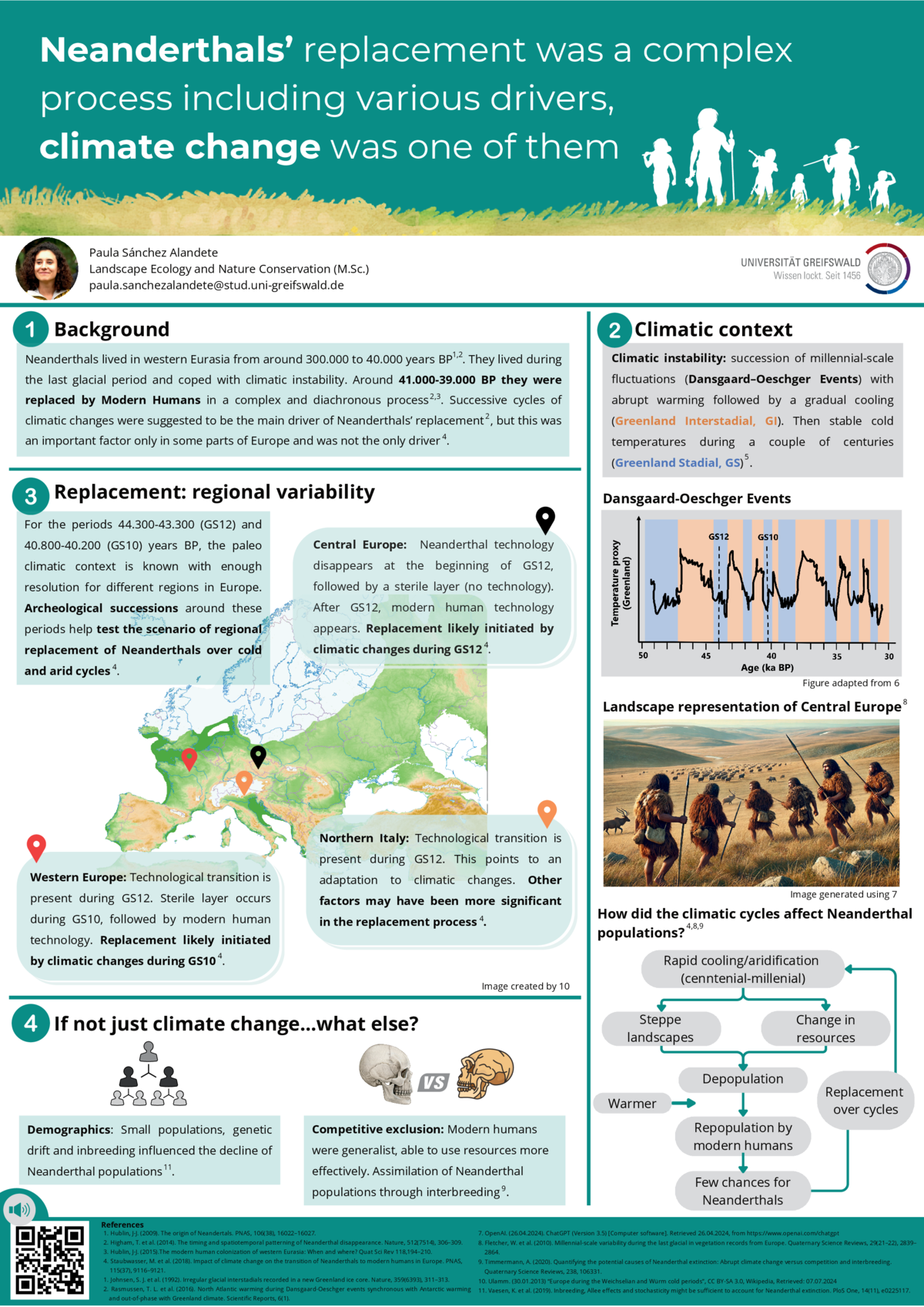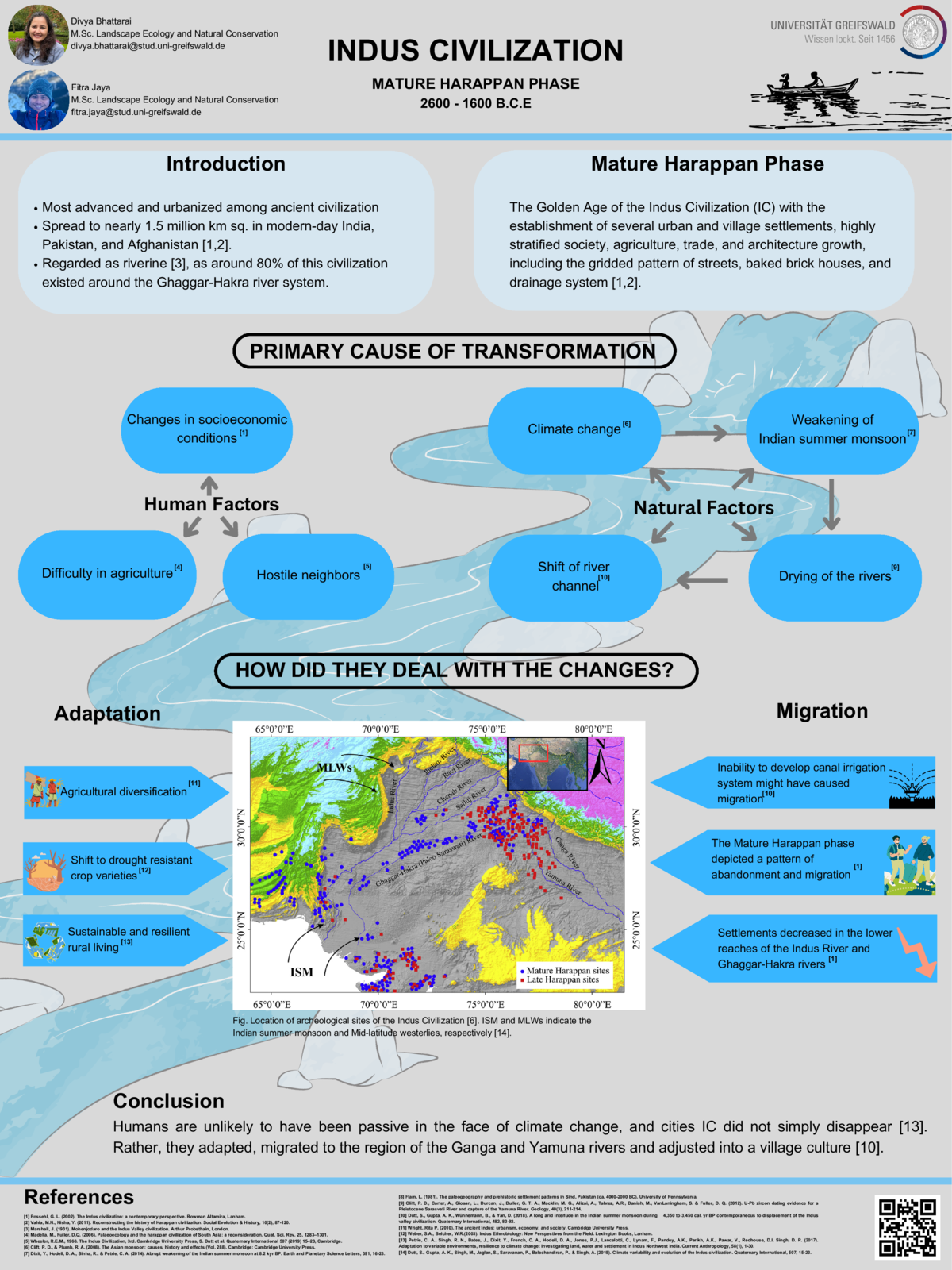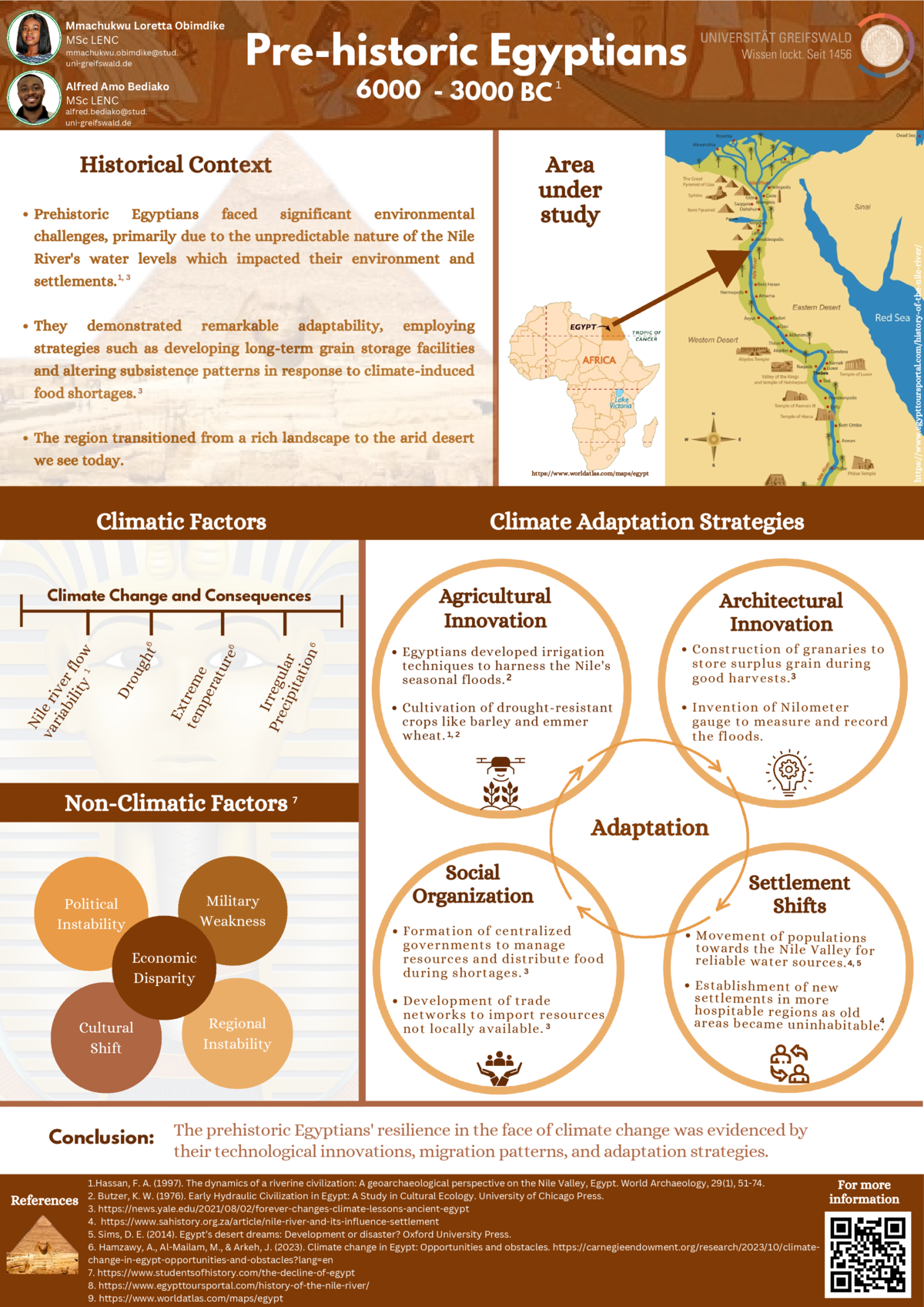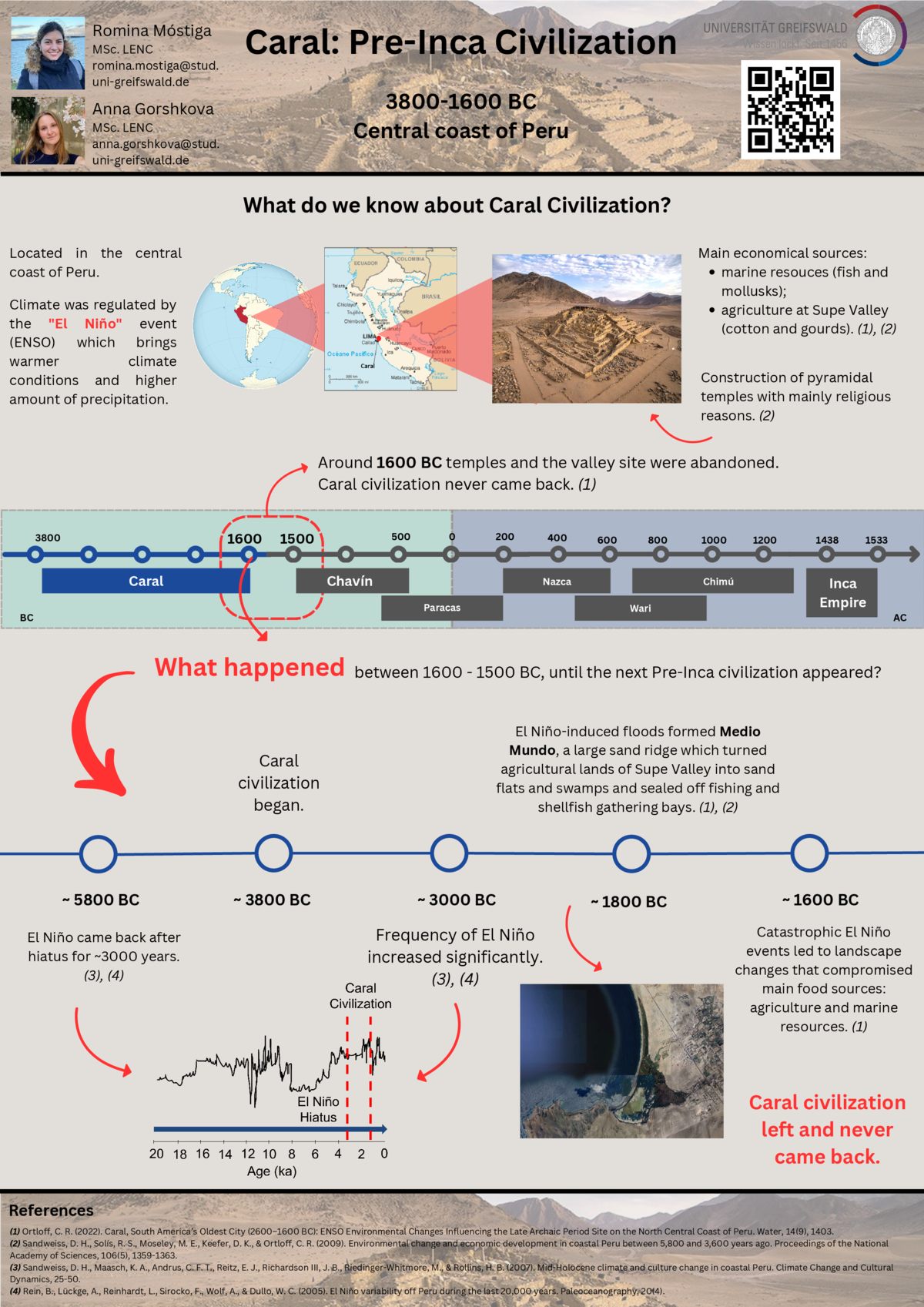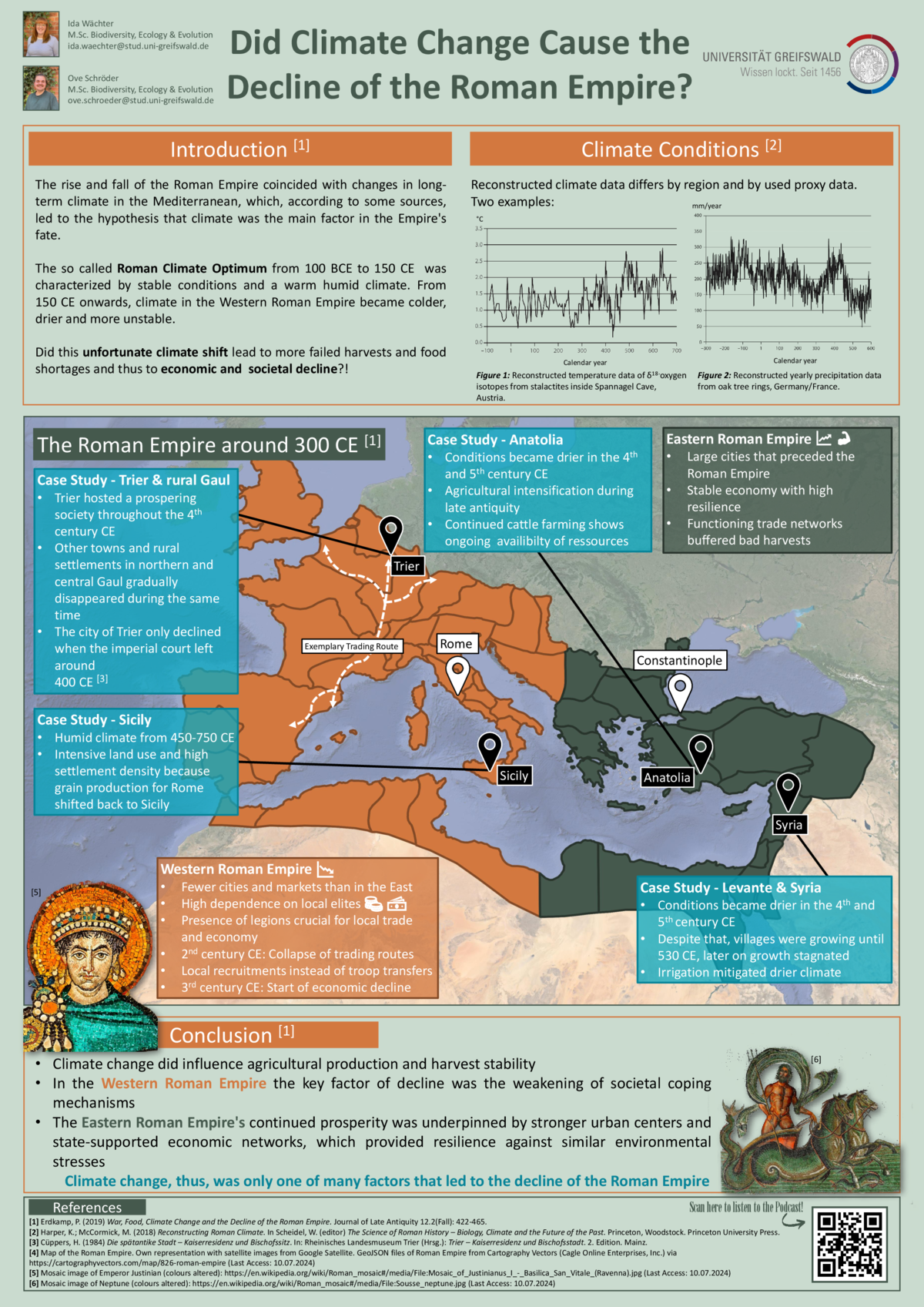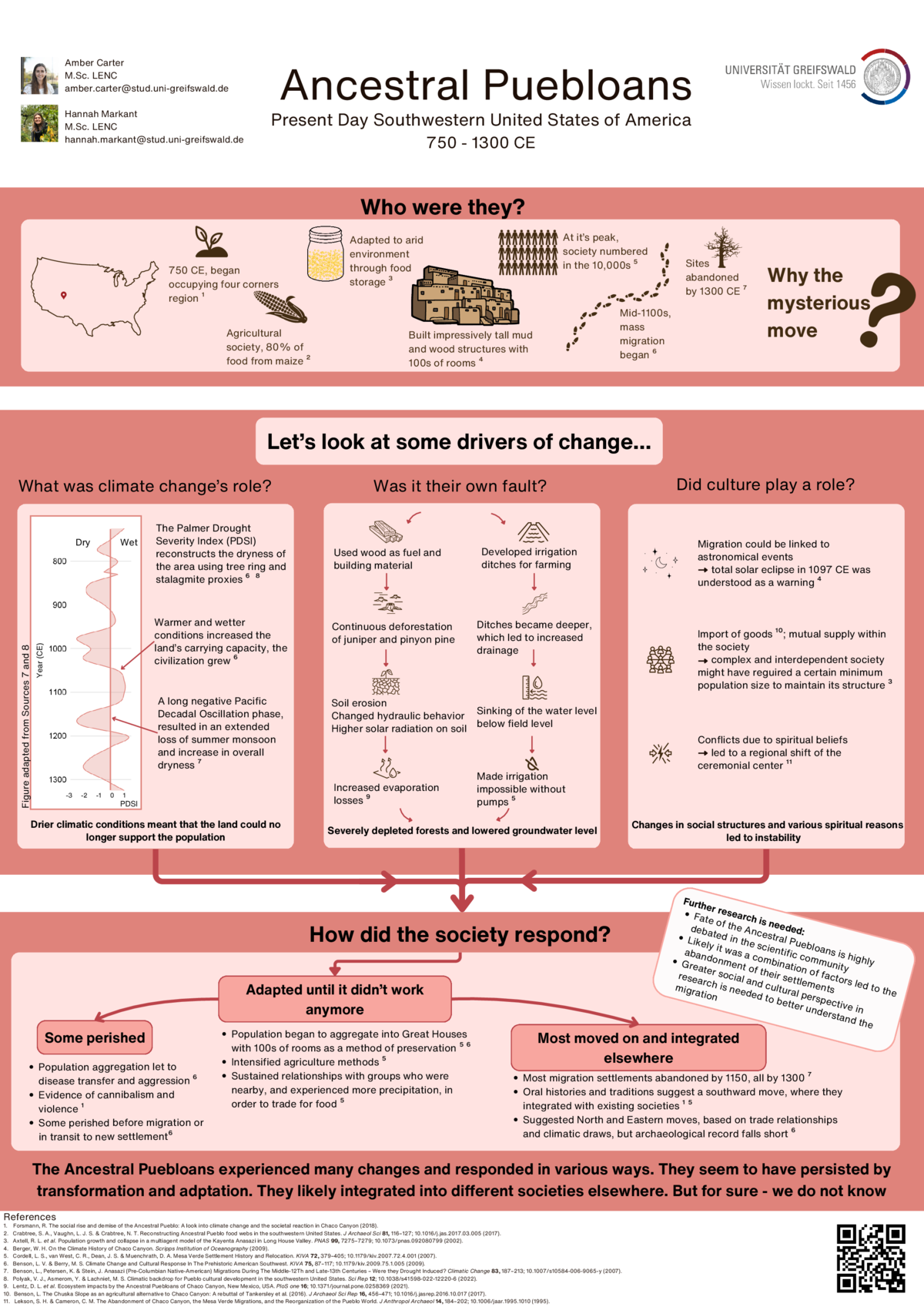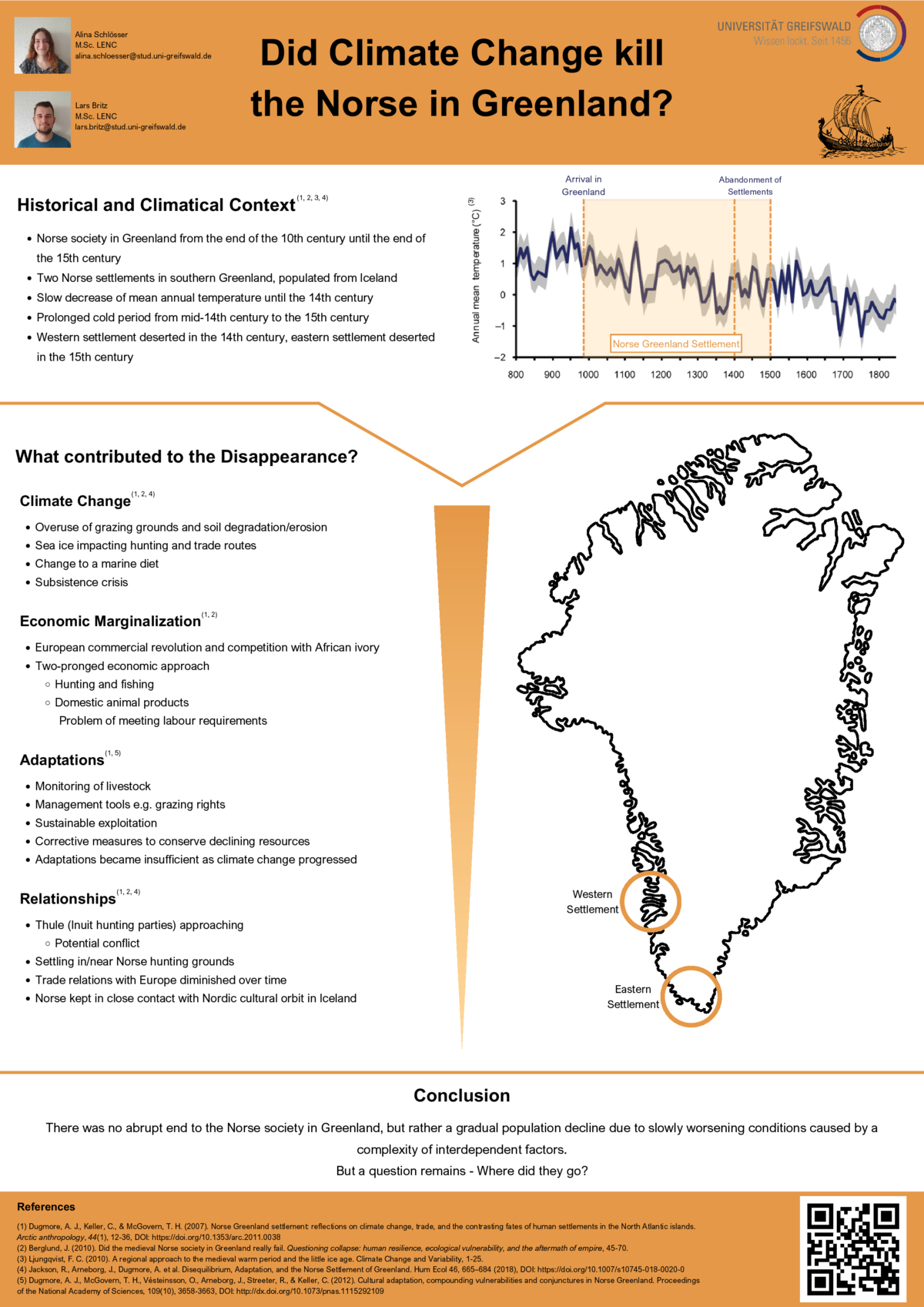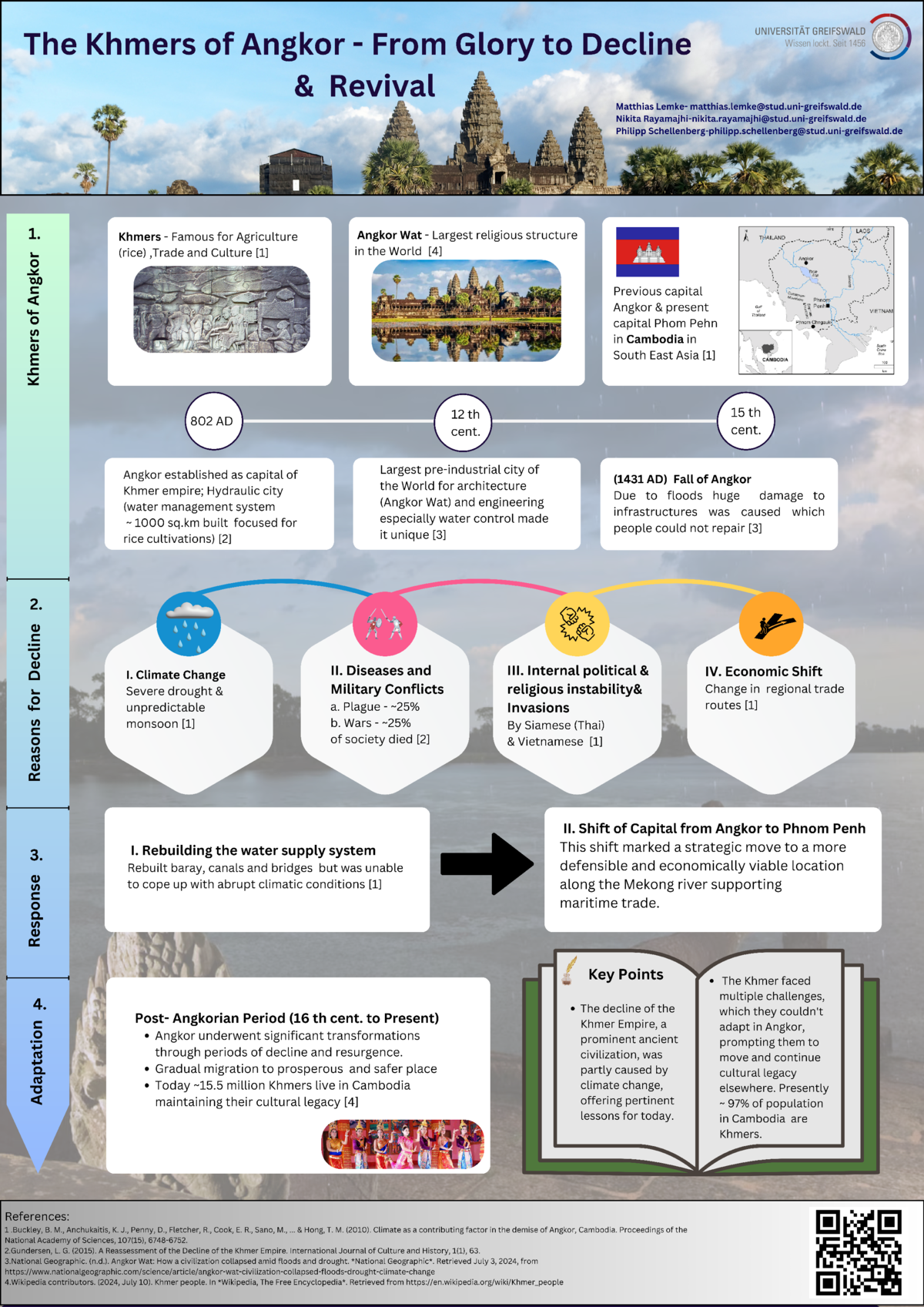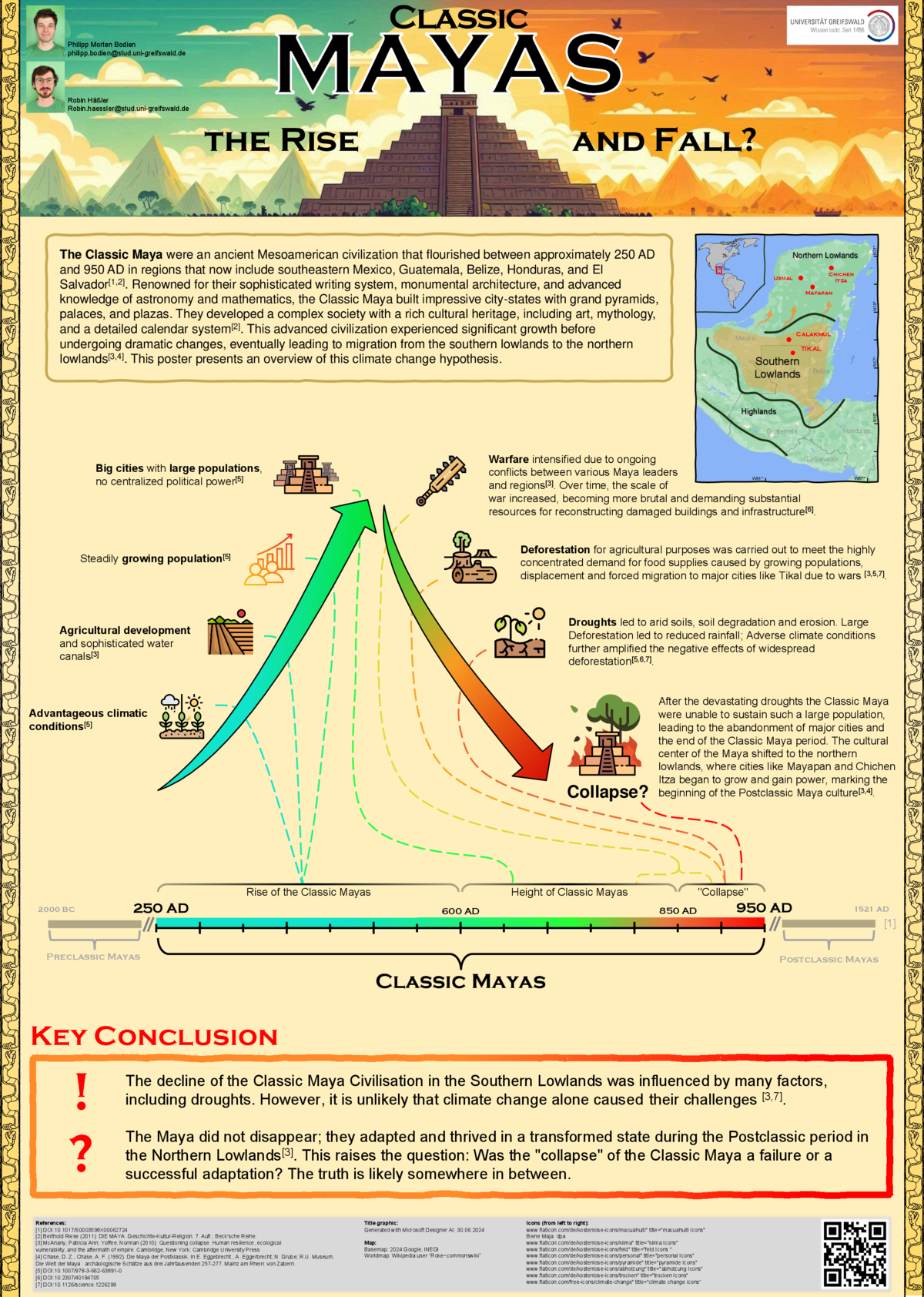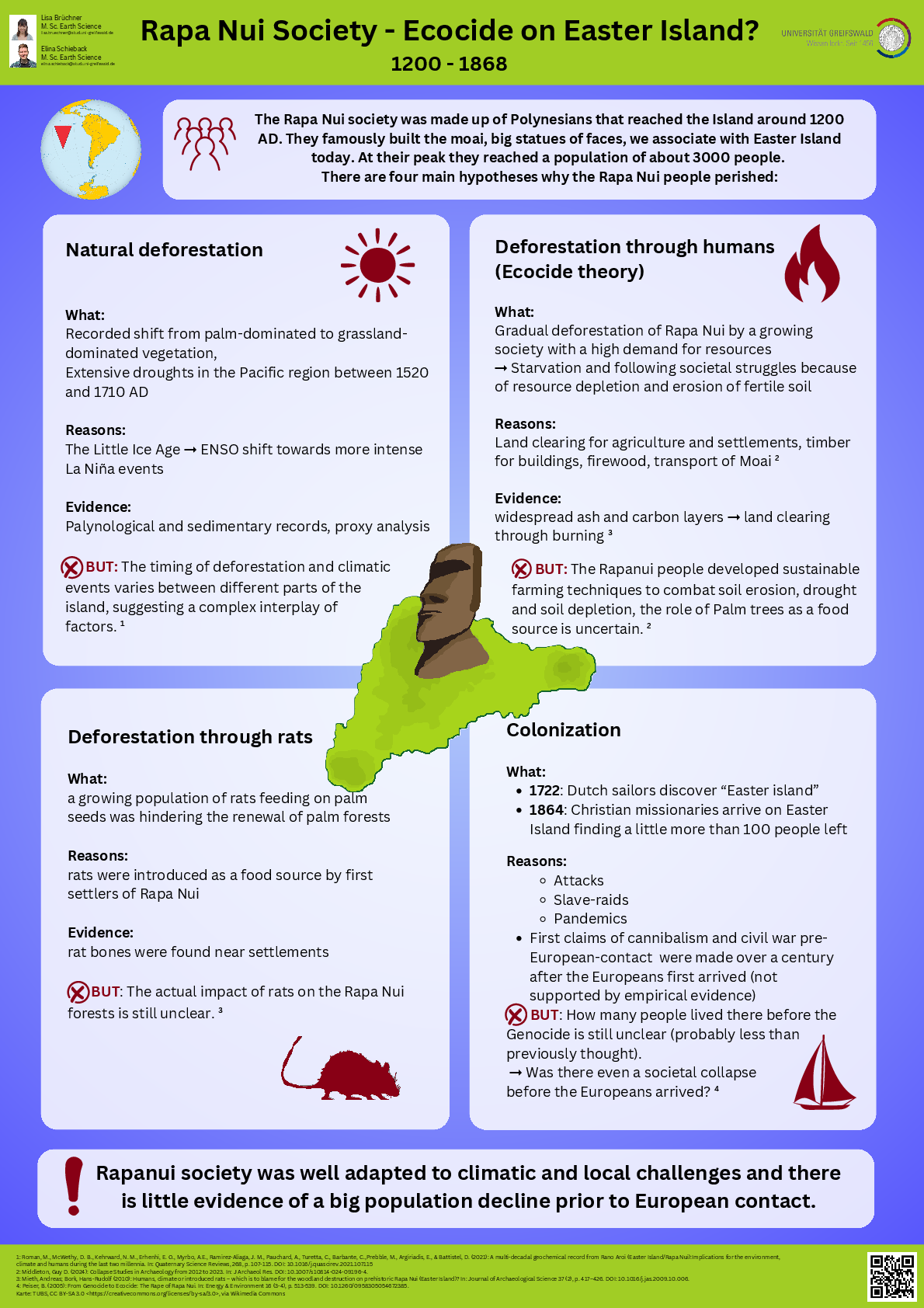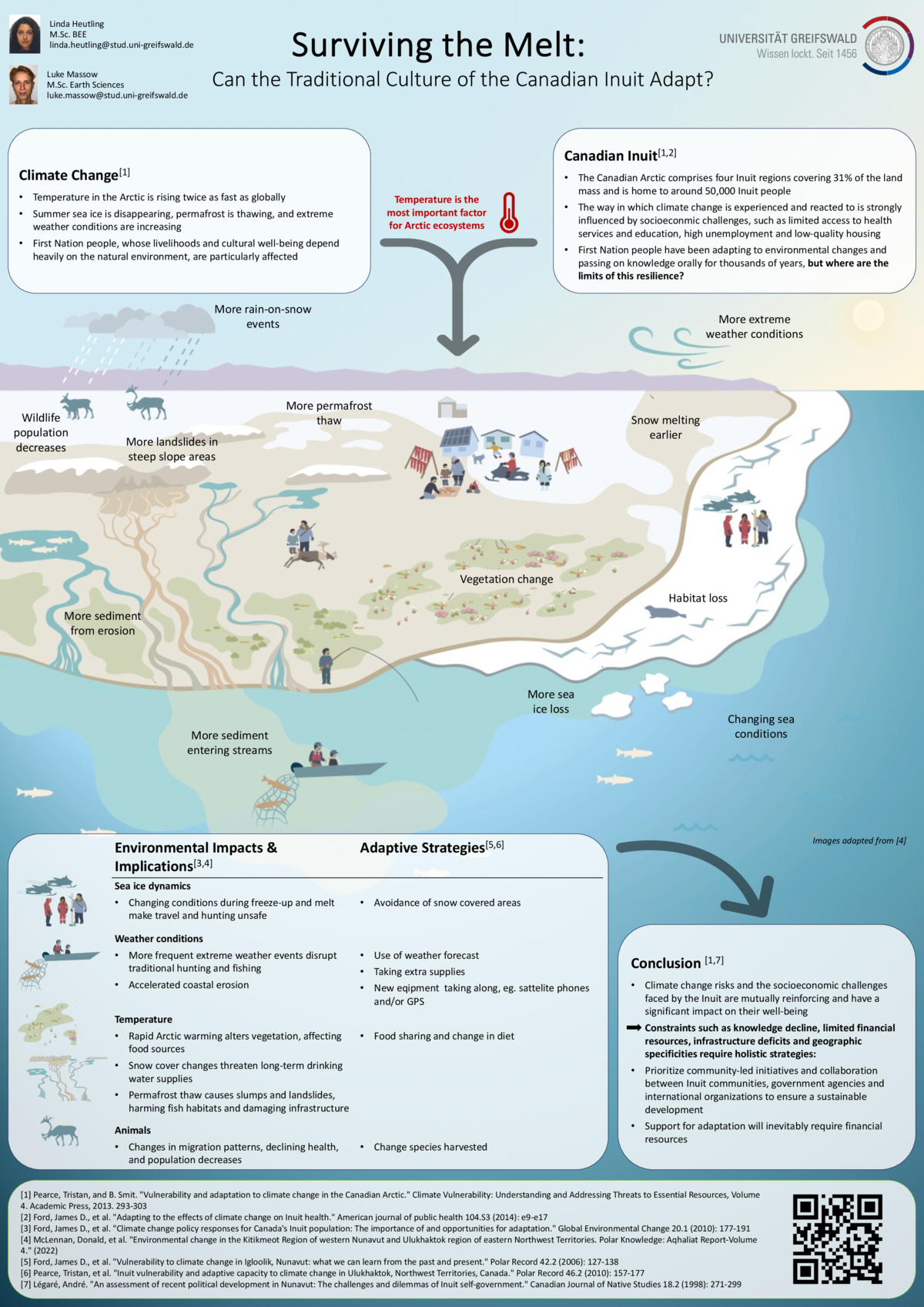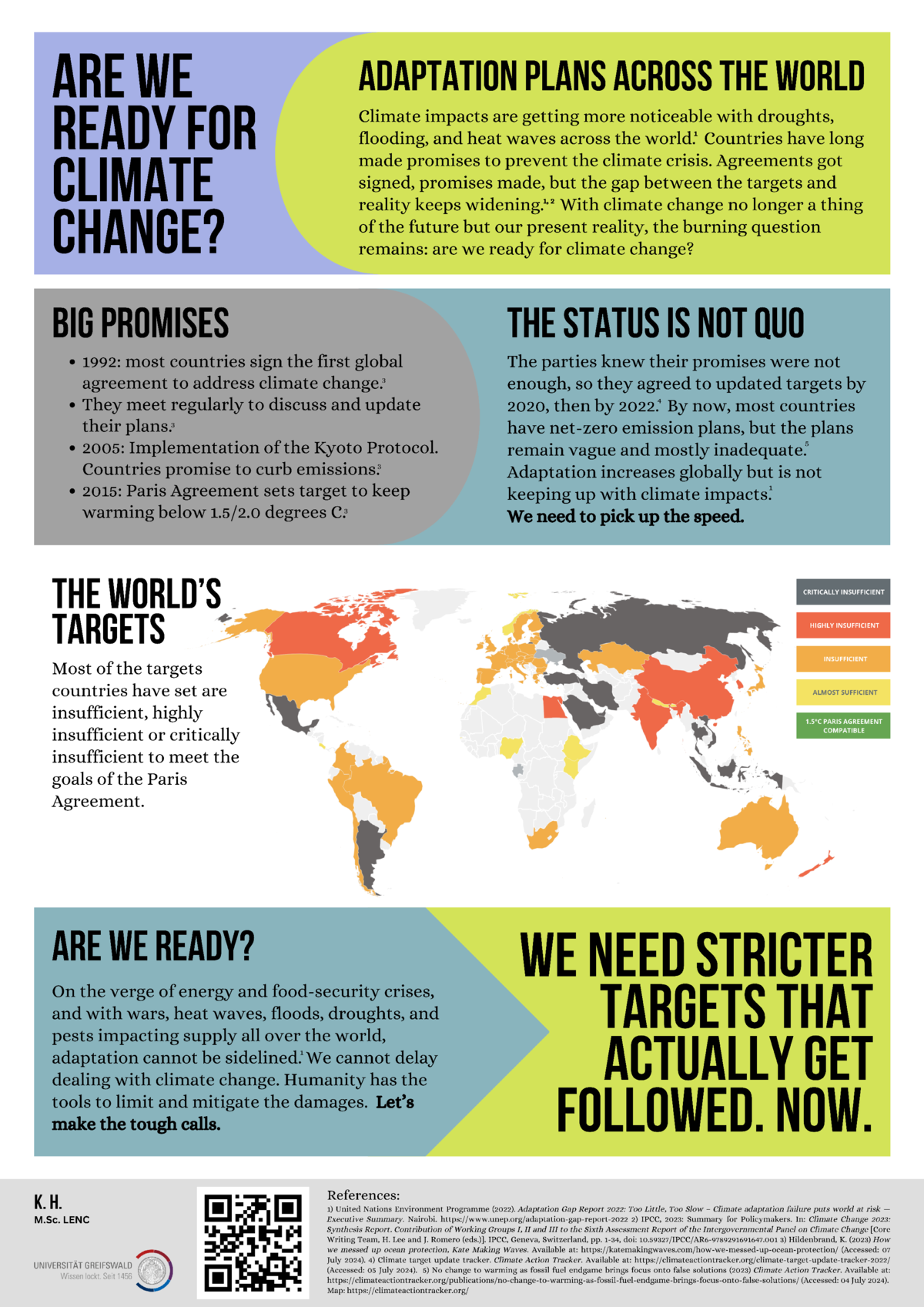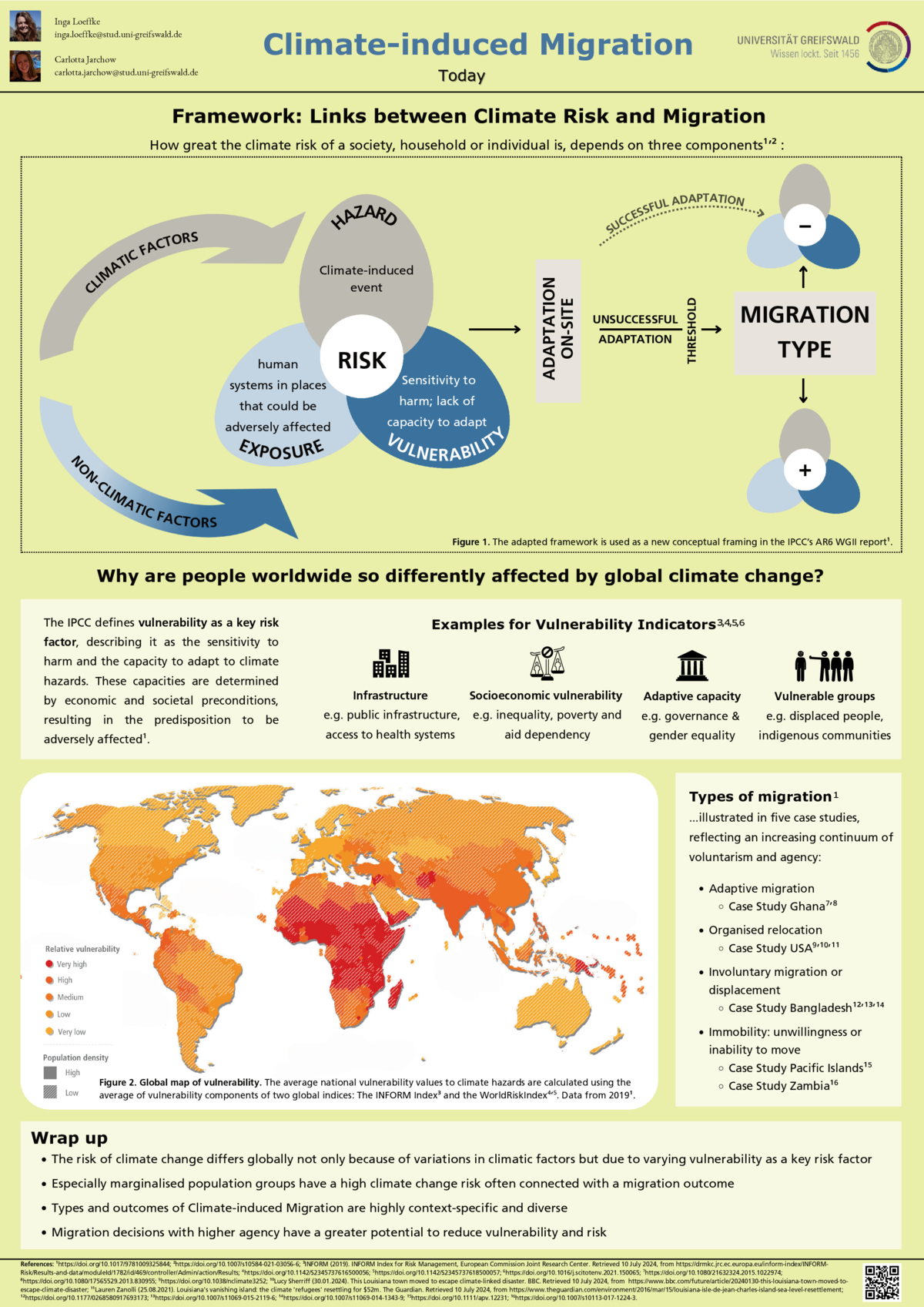
Below you can find all the contributions from students in the summer semester 2024 in the "Climate Change" module from Prof. Martin Wilmking, Ph.D.
For every topic you can find a short overview, the student's poster contribution and a 5 minutes podcast.
Enjoy the virtual tour.
Adapt, Move or Perish - Climate Change and (early) human societies: Full Podcast
1) It’s all about the climate...? Why do societies change?
Before we have a closer look at different case studies, we set a theoretical framework: How do we view and evaluate ancient human societies? What are their internal and external drivers of change? What could drive them to adaption, migration or demise?
Case studies
2) Neanderthals’ replacement was a complex process including various drivers, climate change was one of them
The replacement of Neanderthals by modern humans around 41. -39.000 years BP was driven by multiple factors, with climate change playing a significant but regionally variable role. During the last glacial period, abrupt climate fluctuations (Dansgaard–Oeschger events) caused severe cold and arid conditions, leading to demographic shifts in Neanderthal and modern human populations. Archaeological evidence shows regionally diverse responses to these climatic changes, from complete replacement of Neanderthal populations to technological adaptations. Modeling studies indicate that other critical factors, such as Neanderthals' small, genetically isolated populations and competitive exclusion by more adaptable modern humans, also played an important role.
3) Indus civilization - Mature Harappan Phase
The Indus Civilization, flourishing between 2600 and 1900 B.C.E., was one of the most advanced and urbanized ancient societies, spanning nearly 1.5 million square kilometers in modern-day India, Pakistan, and Afghanistan. Renowned for its urban planning, architecture, and social structure, its Mature Harappan Phase marked significant advancements in agriculture, trade, and technology. This golden age saw numerous urban and village settlements. However, climate change weakened the Indian Summer Monsoon and dried the Ghaggar-Hakra river system, causing instability and leading to agricultural shifts from barley to millet. The civilization faced abandonment and migration, but its urban legacy remains significant in human history.
4) Pre-Historic Egyptians
What led to the fall of ancient Egypt – a powerful and technologically advanced civilization? How did what we know as ancient Egypt evolve into the nation of Egypt we know today? The fall of ancient Egypt was precipitated by a confluence of internal strife, economic instability, foreign invasions, and climate change. Environmental shifts, such as prolonged droughts, led to agricultural decline and societal stress, weakening the once-thriving civilization.
5) Caral: Pre-Inca civilization
Caral, a civilization that developed between 3800-1600 BC on the central coast of Peru, is among the earliest complex societies in the Americas. The onset of El Niño around 5800 BC coincided with the start of monumental construction on the Peruvian coast, while the increased El Niño frequency after 3000 BC correlated with the abandonment of temples by 1600 BC. This poster analyzed if climate change was the main factor affecting the Caral civilization using Computational Fluid Dynamics modeling and fossil analysis.
6) Did Climate Change cause the decline of the Roman Empire?
The rise and fall of the Roman Empire coincided with changes in long term climate in the Mediterranean, leading to the hypothesis that climate was the main factor for the Empires fate. However, changes in climate towards unfavourable conditions during late antiquity are not sufficient enough to explain different episodes of decline across the Roman world. Specialised regional economies resulted in a higher degree of resilience in the eastern half of the empire, allowing it to prosper far into the sixth century CE. Invasions by neighbouring tribes and socio-political disruption eventually led to the demise of the late Roman Empire.
7) Ancestral Puebloans
The Ancestral Puebloans occupied the four corners region of the present day United States of America in 750 CE, began migrating out around 1100 CE, and left all of their settlements abandoned by 1300 CE. There are multiple theories within the scientific community explaining why the civilization moved, including climate change, environmental degradation, and a combination of cultural, religious, and political reasons. Adaptation to changing climate, environments, and political situations was successful for a time until the depleted population moved away from their settlements and integrated into different societies. Further research is needed to fully understand their migration.
8) Did Climate Change kill the Norse in Greenland?
At the end of the 10th century, the first Norse settlers originating from Iceland began settling in southern Greenland, ultimately forming two major settlements. These settlements were abandoned by the end of the 15th century. Many hold a changing climate responsible and are quick to call the disappearance of this society a collapse. However, it is more likely, that a multitude of problems caused this society to slowly shrink and ultimately drove the last few Norse out of their Greenland homes. A combination of climatic and economic factors, insufficient adaptations and potential conflicts are likely responsible for the disappearance of this society.
9) The Khmers of Angkor - From Glory to Decline and Revival
The Khmer Empire, a prominent Southeast Asian civilization, prospered with Angkor as its capital, which was once the largest city in the world. During the 15th century, the empire faced numerous difficulties, including warfare, economic changes, disease, and climate change. These challenges led to the fall of Angkor and the empire's decline, prompting the population to migrate. Today, 97% of the Khmer Empire's descendants live in Cambodia, preserving their cultural heritage.
10) Classic Mayas - The Rise and Fall?
The Classic Maya civilization, settled between 250 AD and 950 AD on the Yucatán peninsula, is renowned for their then sophisticated culture. Favourable climatic conditions enabled the development of complex city-states. Changes within Maya society eventually led to the abandonment of large cities. The most widely accepted theory explaining these changes is linked to man-made factors and climate change. The Maya adapted by migrating to the northern lowlands, ushering in the Postclassic period. This narrative invites readers to reconsider whether the "collapse" of the Classic Maya was truly a failure or an adaptation to changing circumstances. Ready for dive in deeper?
11) Rapa Nui Society - Ecocide on Easter Island?
The widespread theory of the man-made “ecocide” through deforestation on Rapa Nui has been challenged by researchers in recent years. Population sizes have been massively overestimated and thus supported the theory of a big societal collapse. Recent research suggests that Rapanui society was well adapted to the unwelcoming environment they lived in and the climatic challenges they faced. Claims of a chaotic and cannibalistic society, which sparked the catastrophic collapse theory, were spread by European settlers. It is very likely that the Rapanui society succumbed to foreign illnesses and conflict with European settlers.
12) Surviving the Melt: Can the Traditional Culture of the Canadian Inuit adapt?
Climate change is causing Arctic temperatures to rise at twice the global rate, leading to disappearing summer sea ice, thawing permafrost, and more extreme weather. These changes severely impact the Canadian Inuit, whose livelihoods and cultural well-being depend heavily on the natural environment. Socioeconomic challenges like limited healthcare, high unemployment, and poor housing worsen these effects. Adaptation strategies, including modified hunting practices, new technologies, and traditional knowledge, are essential. However, addressing these combined pressures requires holistic strategies: decentralized governance, community-led initiatives, and collaboration among Inuit communities, government, and international organizations, alongside necessary financial support to ensure sustainable development and resilience.
Nowadays
13) Are we ready for climate change? Adaptation Plans across the World
Climate impacts are getting more noticeable with droughts, flooding, and heat waves across the world. Countries have long made promises to prevent the climate crisis. Agreements got signed, promises made, but the gap between the targets and reality keeps widening. With climate change no longer a thing of the future but our present reality, the burning question remains: are we ready for climate change?
14) Climate-induced Migration
Our poster explores the consequences of failed in-situ adaptation to climate hazards, leading to mobility-based responses. We present an IPCC 2022 framework linking climate risk and migration, which emphasizes how the climate risk components Hazard, Exposure, and Vulnerability shape outcomes. Hazards are influenced by climatic factors, while non-climatic factors play a crucial role for Exposure and Vulnerability. Migration outcomes range from voluntary adaptive strategies to involuntary displacement or immobility due to cultural, economic, or social ties. Through five case studies, we illustrate the framework's applicability and the complexity of migration types, highlighting vulnerability as a central, globally unevenly distributed risk factor.

